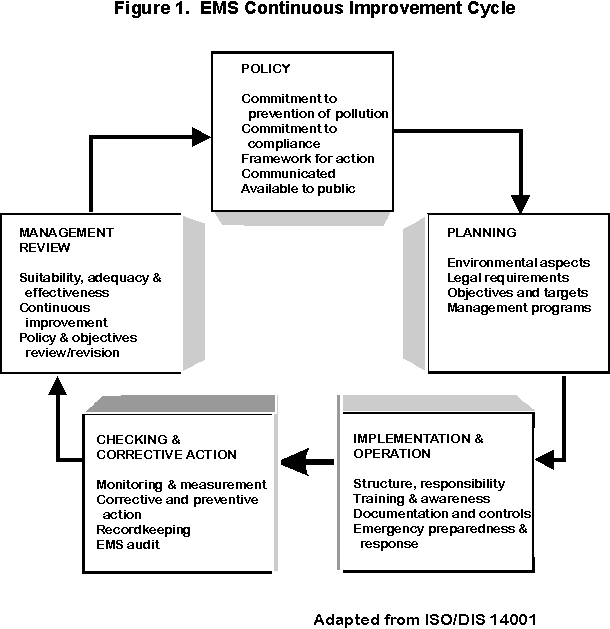-
-
Source: Focus: Waste Minimization, Vol. 5, No. 2, Fall 1996, pp. 1-2

EMS Can Improve Economic and Environmental Performance
Recognizing that environmental excellence is a good business strategy and a source of new opportunities, many organizations are implementing environmental management systems (EMSs) to improve economic and environmental performance.
A new international EMS standard, ISO 14001, sets up an accepted model for an EMS. This article will describe the principles of an EMS and the elements of the ISO 14001 model.
As Figure 1 illustrates, five major components comprise the ISO 14001 EMS model. This model follows the total quality management cycle of Plan-Do-Check-Act that leads to continued improvement.

Getting Started
Most organizations already have certain elements of an EMS in place, although their system may not be structured to follow the 14001 model. How can your organization implement or improve upon an existing EMS? A ISO 14004 guidance document will accompany the standard, and many courses and workshops are currently being offered.
EMS Principles
According to the draft ISO 14001 standard and ISO 14004 guidance, an EMS should be based upon the following principles:
- Rank environmental management among corporate priorities;
- Emphasize pollution prevention;
- Establish communication within the organization and constituents;
- Enhance management and employee commitment to environmental protection;
- Encourage environmental planning throughout the life cycle of the product and/or process; and
- Improve the EMS by proper auditing and review procedures.
Policy Requirements
The 14001 specification standard contains six commitments that an organization must include in its environmental policy statement. These commitments include compliance with applicable regulations, prevention of pollution, and continuous improvement of the EMS. The policy must provide a framework to establish and review environmental objectives and targets; must be documented, implemented, maintained, and communicated; and must be available to the public. Each organization will establish its own environmental targets and objectives appropriate to its environmental impact, but these targets and objectives must be consistent with commitments and leadership demonstrated in the environmental policy.
EMS Benefits
Potential benefits of implementing an EMS include the following:

Demonstrated commitment to environmental goals,

Improved public/community relations,

Adherence to vendor certification requirements,

Enhanced market shares,

Improved operational efficiency,

Reduced environmental liabilities,

Conservation of resources,

Favorable insurance and loan status, and

Better industry-government relations.
The Initial Environmental Review
Before an organization can establish an EMS, an Initial Environmental Review (IER) should be completed (Figure 2). A key segment of the IER is the compilation of applicable regulations and review of compliance performance. The IER will also identify environmental aspects (elements that can interact with the environment) and impacts of an organization's activities, products, or services.
Figure 2. General Topics of an Initial Environmental Review
- Site background information
- Process overview
- Appplicable regulations
- Compliance and conformance - past, present, and future
- Operations - raw material through final product
- Current environmental management procedures
- Apparent environmental issues - general and site-specific
- Identification of environmental "aspects" with significant environmental impact and liabilities
- Environmental performance: Waste/emissions generation and releases
- Raw material usage
- Energy usage
- Procurement, contractor, and transporter requirements
- Current environmental policy
- Emergency response systems
- Feedback from studies, constituents, etc.
- Identification of performance impediments
Contact the American National Standards Institute (ANSI) at 212-624-4900 for copies of the draft standards and the NC Division of Pollution Prevention and Environmental Assistance at 919-715-6500 for a full list of ISO 14000 resource providers, contacts, and upcoming events.
Hit Back Key to Return to Last Page Visited

-